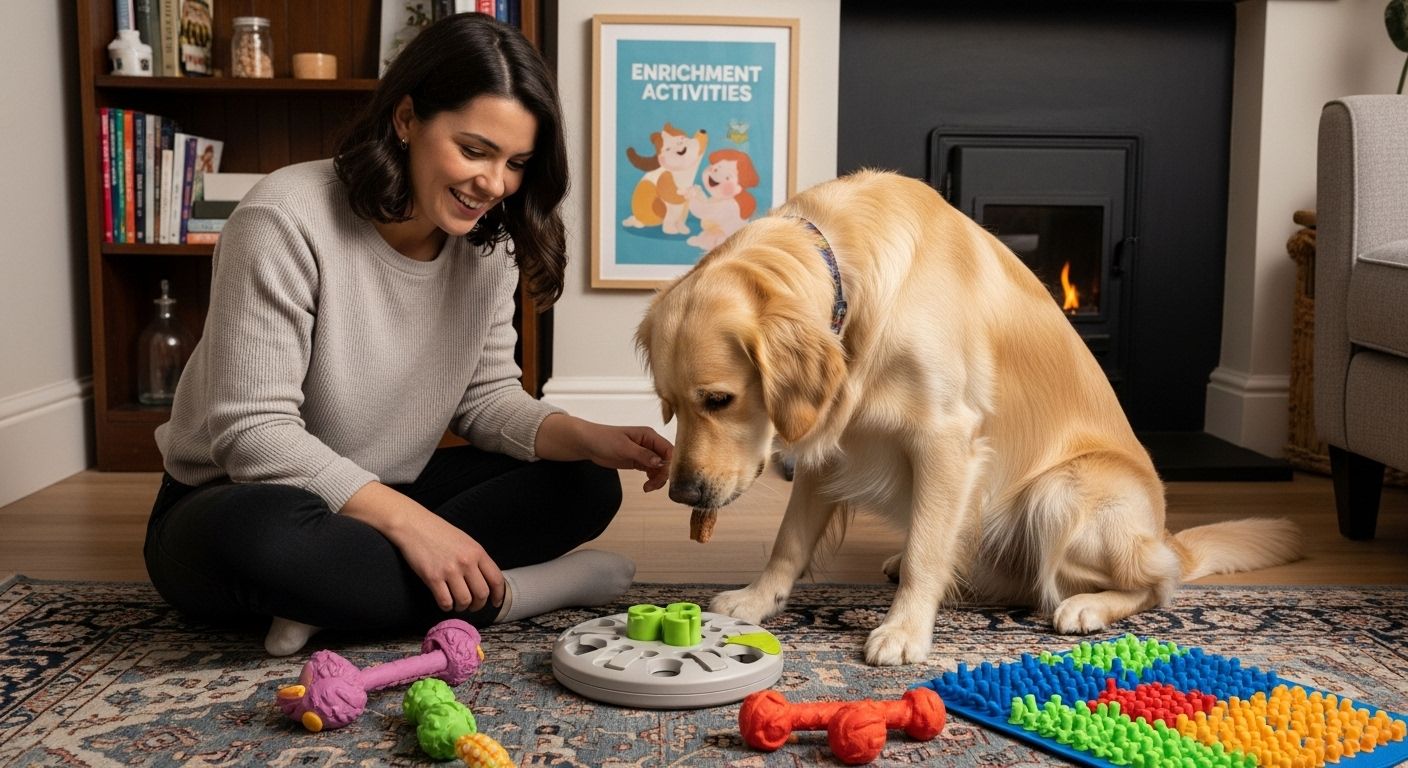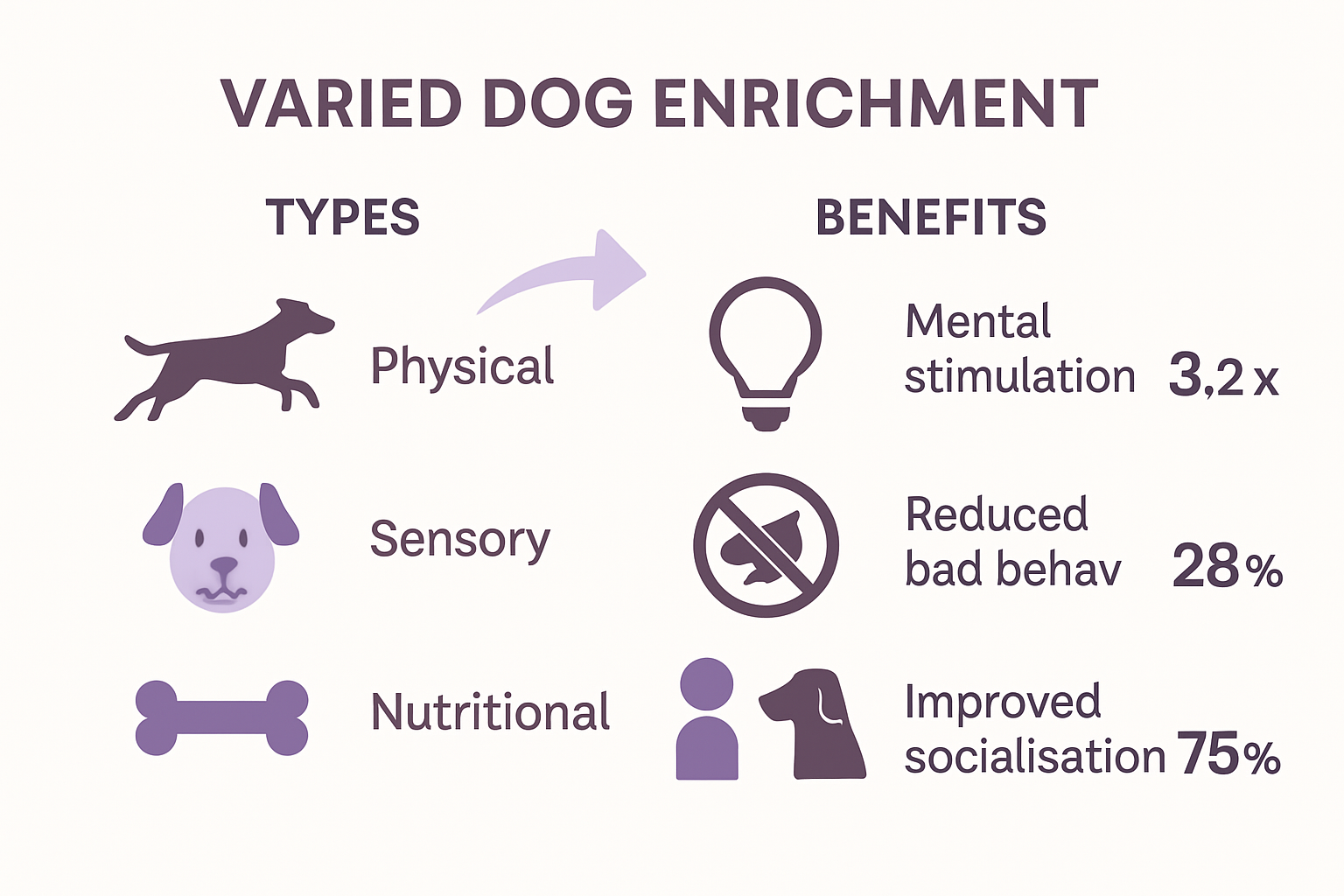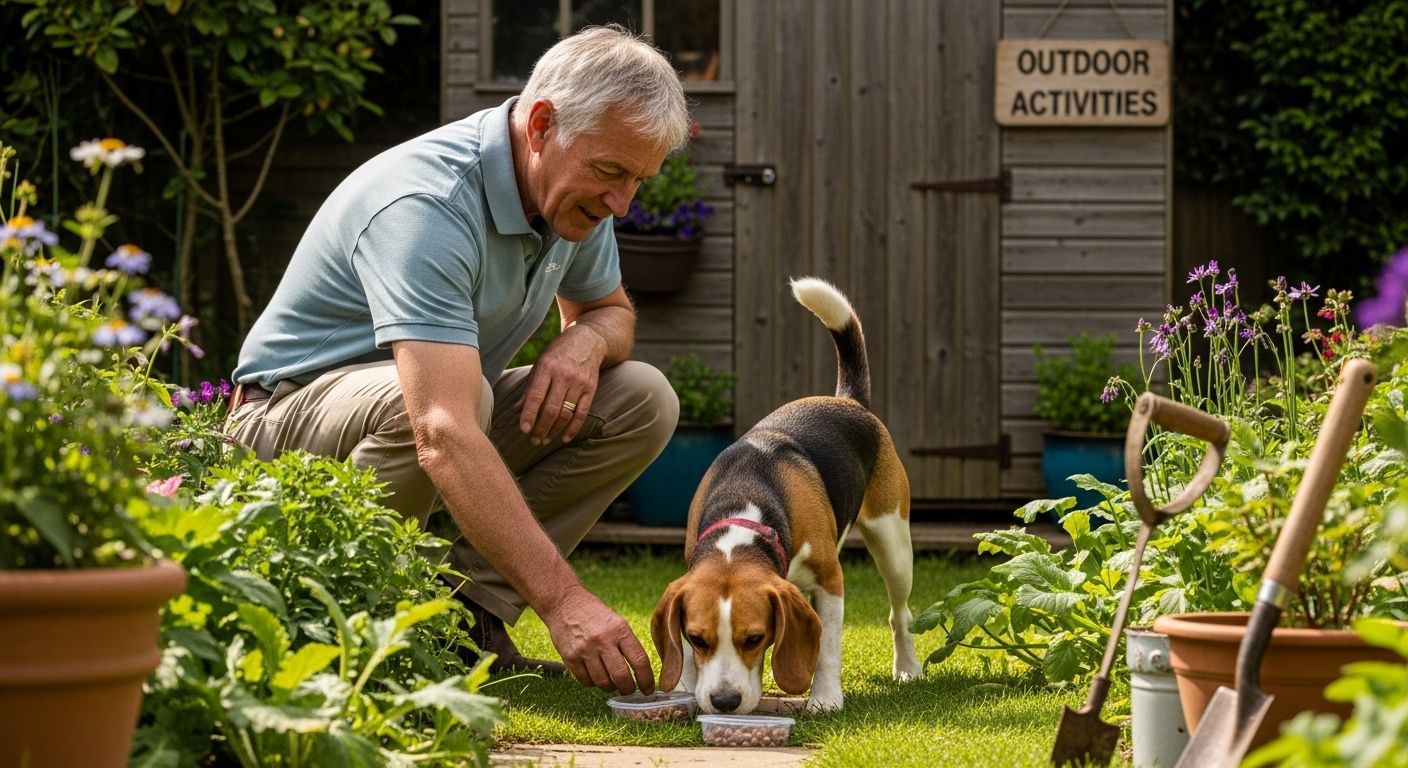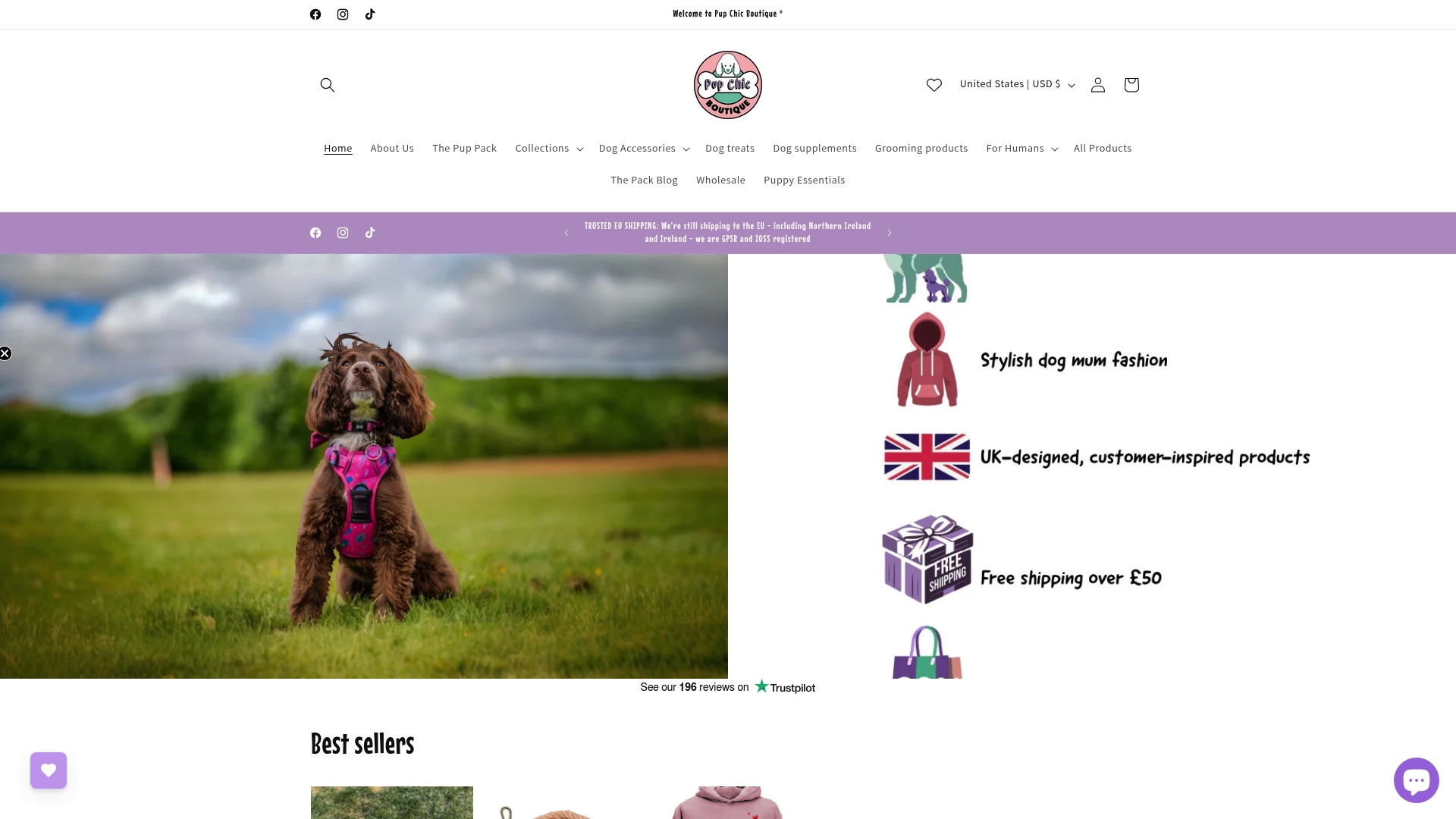
Dog enrichment activities are quickly becoming a favourite among UK owners, and for good reason. Dogs offered varied enrichment can see desirable behaviours like calm sitting leap from 22 percent to a whopping 65 percent, according to clinical studies. Yet most people still think a quick walk or a basic toy now and then will keep their dog happy. The real surprise is that true dog happiness and good behaviour come from mixing up mental, sensory, and social challenges as part of everyday life, not just the odd treat or outing.
Table of Contents
- Understanding Dog Enrichment Activities
- Indoor Enrichment Ideas For All Weather
- Outdoor Activities For Happy, Healthy Dogs
- DIY Enrichment For Puppies And Adult Dogs
Quick Summary
| Takeaway | Explanation |
|---|---|
| Engage dogs through enrichment activities | Enrichment activities stimulate mental and physical wellbeing, preventing boredom and destructive behaviours. |
| Variety in enrichment is key | Consistently rotate activities and toys to maintain engagement and challenge dogs’ curiosity. |
| Outdoor walks enhance sensory experience | Nature walks allow dogs to explore diverse environments, promoting physical exercise and mental stimulation. |
| DIY activities can be fun and beneficial | Create homemade enrichment tools from household items, tailored to suit individual dog needs and preferences. |
| Socialisation is crucial for behaviour | Structured outdoor experiences help improve social skills and reduce anxiety in dogs by encouraging positive interactions. |
Understanding Dog Enrichment Activities
Dog enrichment activities are more than just playtime. They are strategic approaches designed to stimulate a dog’s mental and physical wellbeing, addressing their natural instincts and preventing boredom. These activities go beyond simple exercise, focusing on engaging a dog’s cognitive abilities, sensory experiences, and innate behavioural patterns.
The Science Behind Canine Enrichment
Research provides compelling evidence for the importance of dog enrichment. A study published in the Journal of the American Veterinary Medical Association demonstrated that targeted enrichment programs can dramatically improve dog behaviour. In shelter environments, dogs participating in food-toy enrichment and training showed significant behavioural improvements. Specifically, desirable behaviours like sitting quietly increased from 22% to 65%, while undesirable actions such as jumping reduced from 57% to just 9%.
Under-stimulation can lead to serious behavioural challenges. According to the Texas Veterinary Medical Foundation, dogs lacking mental and physical stimulation may develop destructive behaviours, excessive vocalization, and compulsive actions. Enrichment activities serve as a critical intervention to prevent these potential issues.
Types of Enrichment Activities
Dog enrichment encompasses diverse strategies targeting different aspects of a dog’s wellbeing. Physical enrichment involves interactive toys and games that challenge a dog’s motor skills and problem-solving abilities. Sensory enrichment explores activities that engage a dog’s keen sense of smell, hearing, and touch. Nutritional enrichment transforms feeding into an engaging experience through foraging games and puzzle feeders.
A pilot study examining environmental enrichment revealed fascinating insights into activity effectiveness. While activities like conspecific play and playhouse experiences showed the most significant behavioural improvements, food-based interactive toys also contributed positively to a dog’s mental stimulation.
For UK dog owners, enrichment activities are not just about entertainment but about creating a holistic approach to canine care. By understanding and implementing these strategies, owners can help their furry companions lead more fulfilling, balanced lives. Whether it’s through scent games, puzzle toys, or structured play, enrichment activities provide mental challenges that are as crucial as physical exercise.
The key is variety and consistency. No single activity will meet all of a dog’s enrichment needs. Instead, owners should create a dynamic environment that continuously challenges and engages their pet’s natural curiosity and intelligence.
To help UK dog owners easily compare the main types of dog enrichment described in this article, the table below summarises each type, its focus, and sample activities.
| Enrichment Type | Focus Area | Example Activities |
|---|---|---|
| Physical Enrichment | Motor skills, physical exercise | Interactive toys, games, obstacle courses |
| Sensory Enrichment | Engaging senses (smell, touch, hearing) | Scent games, sensory exploration |
| Nutritional Enrichment | Making feeding engaging | Foraging games, puzzle feeders |
| Social Enrichment | Social skills, positive interactions | Dog parks, group walks, breed clubs |
| Cognitive Enrichment | Mental problem-solving, training | Puzzle toys, trick training, new commands |

Indoor Enrichment Ideas for All Weather
Indoor dog enrichment activities are essential for keeping your furry companion mentally stimulated and physically active, especially during unpredictable British weather. These activities provide crucial mental challenges that prevent boredom and reduce the likelihood of destructive behaviours.
Interactive Puzzle Toys and Mental Stimulation
According to Purdue University’s Canine Welfare Science program, regular rotation of toys and activities is key to maintaining a dog’s engagement. Interactive puzzle toys offer an excellent way to challenge your dog’s problem-solving skills. These toys can be filled with treats, requiring dogs to work out complex mechanisms to access their rewards. Some options include treat-dispensing balls, sliding puzzle boards, and hide-and-seek style games that encourage cognitive development.
A clinical study published in veterinary research demonstrated that food-based enrichment activities significantly improve dog behaviour. Specifically, dogs engaged in daily food-toy enrichment showed increased desirable behaviours like sitting quietly and decreased undesirable actions such as jumping.
Sensory Exploration and Indoor Games
Indoor enrichment goes beyond physical toys. Scent games are particularly effective for mental stimulation. Create indoor treasure hunts by hiding treats around the house, encouraging your dog to use their powerful sense of smell. Teaching new tricks, practicing obedience training, or setting up indoor obstacle courses can provide excellent mental and physical challenges.
Consider creating a dedicated play area with rotating toys to maintain novelty. This approach prevents monotony and keeps your dog’s interest high. Tug games, gentle wrestling, and hide-and-seek can be adapted to indoor spaces, providing interactive experiences that strengthen the bond between you and your pet.
Technology and Advanced Enrichment Strategies
Modern technology offers innovative enrichment options. Interactive cameras that dispense treats, automated ball launchers, and puzzle feeders can provide stimulation when you’re busy. However, these should supplement, not replace, direct interaction with your dog.
Rotating toys weekly prevents boredom. Store some toys away and reintroduce them periodically to maintain excitement. Soft toys, chew toys, and interactive feeders can be mixed to provide varied experiences. The goal is to create an environment that continuously challenges and engages your dog’s natural curiosity.
Remember, each dog is unique. What works for one might not work for another. Observe your dog’s preferences and adjust enrichment activities accordingly. The most successful indoor enrichment strategies are those tailored to your dog’s individual personality and energy levels.
Outdoor Activities for Happy, Healthy Dogs
Outdoor activities are crucial for a dog’s physical and mental wellbeing, offering essential opportunities for exercise, exploration, and sensory stimulation. According to the ASPCA, these activities are fundamental in supporting a dog’s overall health, preventing obesity, and encouraging crucial socialization experiences.
Nature Walks and Exploration Adventures
Nature walks provide more than just physical exercise. They offer dogs a rich sensory experience, allowing them to explore diverse environments, encounter new scents, and engage their natural curiosity. Different terrains like woodland paths, park trails, and open fields challenge a dog’s physical abilities and mental engagement. Varying walking routes prevents monotony and keeps outdoor experiences exciting.
Consider incorporating training elements during walks. Practice recall commands, loose leash walking, and basic obedience in different environments. This approach transforms walks into interactive learning experiences that strengthen the bond between dog and owner while providing mental stimulation.
Interactive Outdoor Games and Skill Development
Beyond standard walking, interactive games can significantly enhance outdoor enrichment. Fetch, frisbee, and hide-and-seek are excellent activities that combine physical exercise with mental challenge. These games tap into a dog’s natural retrieving and tracking instincts, providing comprehensive stimulation.
Agility-based activities offer another dimension of outdoor enrichment. Simple obstacle courses using natural elements like logs, rocks, and slight elevation changes can provide excellent physical and cognitive challenges. For dogs with high energy levels, these activities help channel their enthusiasm constructively and prevent potential destructive behaviours.
Socialization and Structured Outdoor Experiences
Outdoor activities present unique socialization opportunities. Controlled interactions with other dogs in designated areas like dog parks or during structured group walks can help develop crucial social skills. These experiences teach dogs appropriate social behaviours, reduce anxiety in new situations, and provide mental stimulation through positive interactions.
For owners seeking structured experiences, consider joining local dog walking groups or participating in breed-specific activity clubs. These communities offer guided experiences that combine professional supervision with social interaction, ensuring safe and enriching outdoor adventures.
When planning outdoor activities, consider your dog’s individual characteristics. Age, breed, fitness level, and personal temperament should guide the intensity and type of outdoor enrichment. Younger, high-energy breeds might enjoy more vigorous activities, while older or smaller dogs might prefer gentler, shorter excursions.
Always prioritize safety during outdoor activities. Ensure your dog is appropriately vaccinated, use reliable identification tags, carry water, and be mindful of weather conditions. In warmer months, plan activities during cooler parts of the day and watch for signs of overexertion.
Outdoor enrichment is not just about physical movement but creating holistic experiences that satisfy a dog’s natural instincts. By thoughtfully designing outdoor activities, owners can provide their dogs with experiences that promote physical health, mental wellbeing, and emotional satisfaction.

DIY Enrichment for Puppies and Adult Dogs
DIY enrichment activities offer an affordable and creative approach to keeping dogs mentally stimulated and physically engaged. These homemade solutions can be tailored to suit different ages, energy levels, and individual preferences, making them an excellent option for dog owners looking to provide engaging experiences without significant financial investment.
Homemade Puzzle Toys and Feeding Challenges
Transforming everyday household items into enrichment tools can be both fun and cost-effective. Empty plastic bottles with small holes can become treat-dispensing toys, challenging dogs to roll and manipulate the container to release treats. Muffin tins can be repurposed into nose work games by hiding treats under tennis balls, encouraging problem-solving skills and mental engagement.
For puppies, softer puzzle challenges are crucial. Use old towels or blankets to create simple hide-and-seek games, tucking treats within layers that require gentle manipulation. This approach not only provides mental stimulation but also helps develop fine motor skills and gentle interaction techniques.
Sensory Enrichment and Training Integration
DIY sensory experiences can be created with minimal resources. Create scent trails using small amounts of low-sodium broth or safe food items, encouraging dogs to follow and track interesting smells. Indoor obstacle courses using cushions, cardboard boxes, and household items can provide physical and cognitive challenges that adapt to your dog’s specific abilities.
Training can be seamlessly integrated into DIY enrichment. Teaching new tricks using household items as props keeps learning sessions engaging. For instance, teaching a dog to differentiate between various objects, place items in specific locations, or perform sequential tasks can transform ordinary training into an exciting mental workout.
Seasonal and Age-Appropriate DIY Enrichment
Different life stages require unique enrichment approaches. Puppies benefit from softer, more supervised activities that prevent overstimulation, while adult dogs can handle more complex challenges. During colder months, indoor DIY enrichment becomes particularly important. Create rotation systems for toys, introducing novel items periodically to maintain interest.
For senior dogs, gentler enrichment activities are key. Soft puzzle feeders, low-impact nose work games, and calm training sessions can provide mental stimulation without causing physical strain. Consider adapting activities to accommodate any mobility or sensory limitations.
Safety remains paramount when creating DIY enrichment activities. Always supervise your dog, ensure materials are non-toxic and cannot be easily destroyed, and match the complexity of the activity to your dog’s individual capabilities. Regularly inspect homemade toys for wear and tear, replacing them when they show signs of damage.
The most successful DIY enrichment strategies are those that consider your dog’s unique personality. Some dogs might prefer food-based challenges, while others enjoy problem-solving or interactive games. Observe your dog’s responses, be willing to experiment, and most importantly, make the experience enjoyable for both of you.
The table below outlines popular DIY enrichment ideas mentioned in the article, their main purpose, and which age group of dogs they are best suited for. This will help owners select appropriate and safe options for their dog’s needs.
| DIY Enrichment Idea | Main Purpose | Suitable for Puppies/Adults/Seniors |
|---|---|---|
| Plastic bottle treat dispenser | Problem-solving, treat reward | Adults (supervised for puppies) |
| Muffin tin nose work game | Scent work, problem solving | All ages (supervised for puppies) |
| Towel/blanket hide-and-seek | Gentle puzzle, motor skills | Puppies, seniors |
| Scent trails (broth/food) | Scent tracking, curiosity | All ages |
| Indoor obstacle course | Physical, cognitive challenge | Adults, fit seniors, older puppies |
| Soft puzzle feeders | Gentle mental stimulation | Seniors, puppies |
| Training with household objects | Cognitive, training integration | All ages |
Remember that DIY enrichment is not about creating complex or expensive solutions, but about creativity, interaction, and understanding your dog’s individual needs. With imagination and careful planning, household items can be transformed into engaging, stimulating experiences that support your dog’s mental and physical wellbeing.
Frequently Asked Questions
What are some effective indoor dog enrichment activities?
Indoor dog enrichment activities can include interactive puzzle toys, scent games, indoor obstacle courses, and training sessions. These activities stimulate your dog’s mental capabilities and prevent boredom, especially during inclement weather.
How can I create DIY enrichment toys for my dog?
You can create DIY enrichment toys using household items like empty plastic bottles for treat-dispensing toys or muffin tins for nose work games. Ensure the items are safe for your dog and supervise them during play.
Why is dog enrichment important for behaviour?
Dog enrichment activities are essential for mental and physical wellbeing. Engaging in varied enrichment can improve a dog’s behaviour, reducing undesirable actions and enhancing positive traits like calmness and focus.
What types of outdoor dog enrichment activities should I try?
Outdoor enrichment activities include nature walks, interactive games like fetch and hide-and-seek, and socialisation at dog parks. These activities promote physical health and provide essential sensory stimulation for your dog.
Unlock the Power of Enrichment with Pup Chic Boutique
You know your dog craves more than just a walk or a quick game. The insights you discovered in our article show that real dog happiness comes from new experiences, engaging toys, interactive play, and even stylish outings. Yet, keeping enrichment fresh and effective can be a struggle, especially when finding accessories that fit both your lifestyle and your dog’s needs. Many owners face the challenge of rotating enrichment activities while ensuring comfort, safety, and a bit of fun flair. At Pup Chic Boutique, every piece in our collection is inspired by British dog mums looking for practical solutions that keep enrichment engaging and life stylish for both you and your pup.

Ready to make every enrichment adventure better? Discover our beautiful and practical accessories that transform routine walks or indoor games into special moments. Visit Pup Chic Boutique today for no-pull harnesses, hands-free leads, natural treats, and matching human-dog outfits. Elevate your dog’s daily happiness and wellbeing with UK-designed solutions that meet real needs. Act now and bring style, safety, and enjoyment to every activity!
Recommended
-
The Ultimate Guide to Comfort and Safety: Adjustable Harnesses for Ner – Pup Chic Boutique
-
How to Keep Your Dog Cool in Hot Weather | Summer Dog Tips – Pup Chic Boutique
-
Collar or Harness for Your Dog: Making the Right Choice – Pup Chic Boutique
-
Best Collars for Puppies UK Guide 2025: Safe & Stylish Choices – Pup Chic Boutique
-
[
Get Moving: Dog Exercise and You!
– iPupPee](https://ipuppee.com/blogs/news/get-moving-dog-exercise-and-you)




